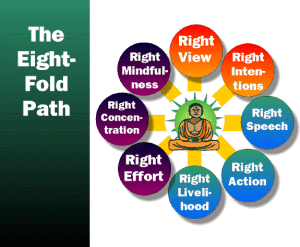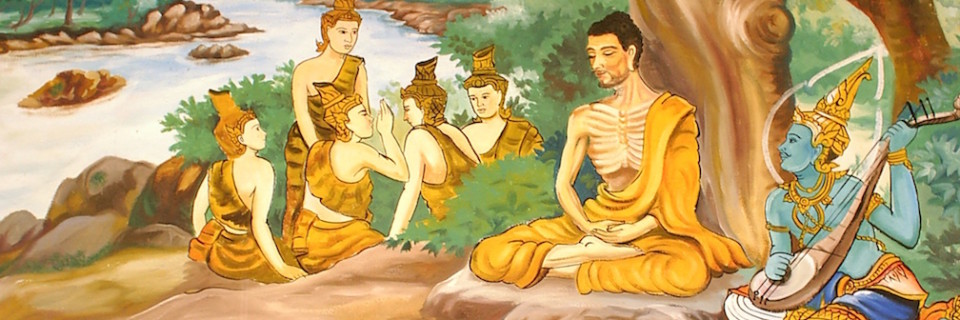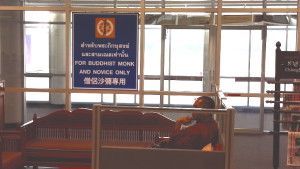Buddhism Starts With The Four Noble Truths
The next 3 posts will be about Buddhism.
Part 1 is a short intro to Buddhism off the top of my head, for those who know little about it, at least as I practice it.
Part 2 is a study of all the types of Buddha statues and iconography that I’ve found in scouring Northern Thailand temples: fascinating for me, and I hope you too!
Part 3 is a study of all the iconography I found in the temples that are NOT Buddha, which are fascinating in their own right.
In this first part, to illustrate how I “use” Buddhist principles, I also let you in on my very personal divorce recovery story.
Around the 5th century BCE an Indian prince named Siddartha Gautama became disenchanted with his privileged life in Northern India, reportedly after seeing someone dying. So he left his wealthy family and sumptuous, well-bubbled home, and began a quest to look for the answer. As you might imagine “stuff happened” which I won’t describe since it’s described so much in other places (see Herman Hesse’s book “Siddhartha” for a good fictional Western interpretation). One day, after much contemplation, Siddartha attained enlightenment and in that instant became the Buddha. The word “Buddha” means “awakened one” in Sanskrit. The Buddha’s teachings spread throughout India and then on to East Asia, getting assimilated in Japan alongside Shintoism, in China with Confucianism, and in SE Asia. Thailand, for example, is a deeply Buddhist country, even giving Buddhist monks special lines and sitting areas in airports. (More on the history of Buddha here.)
To understand my next two posts about the iconography of Thai Buddhism, it helps to understand a little bit about Buddhist principles, because the variance of the statues is due to the effort to express the different aspects and nuances of these principles, as well as the life of the historical Buddha. I won’t go too deep, but most forms of Buddhism start with the Four Noble Truths about life. The interpretations are all mine, and my learning of these is really just starting. And, as promised at the outset of this post, and at the risk of making some of you uncomfortable, I offer up a (formerly) painful personal example to make my experience with each Noble Truth more illustrative!
The Four Noble Truths (by Buddha)
- There is suffering in all of life.
- Suffering has an origin.
- Suffering can cease.
- There is a path out of suffering.
Let’s look at these a bit more closely.
- There is suffering in all of life.
- Suffering is an inevitable quality of living. We experience it when we are born, grow into adults, grow old, and die. Everyone experiences suffering, physically or emotionally, at many points in their life. (more)
- Personal Example: I had a pretty happy and satisfied life with my best friend/wife and young children living in Tucson as a professor, which I loved. Life was exactly as I desired it, and it was good! And then….it fell apart. That life no longer existed, except in my memory. And I suffered profoundly. To this day, it remains my biggest personal trauma.
- Suffering has an origin.
- We suffer because we cling to, desire for, and expect things that don’t exist, or if they have existed, no longer exist. We suffer in this because we don’t fully understand how life really works, that everything in life is transient. (more)
- Personal example: When I got divorced and had to stop living with my sons full time, I suffered because I clung to the idea that I was supposed to, and profoundly desired to, live in an intact loving family. The reality was that my family was no longer “intact”, and never would be again. By clinging to that idea whose time had come and gone, I suffered.
- Suffering can cease.
- Our suffering can cease by letting go of the desire, negativity and ignorance that we hold when we cling to the idea or belief that doesn’t exist. (more)
- Personal Example: By letting go of everything that I held about my idea of “family”, I was able to stop my suffering about losing that version of it. It didn’t mean that I was wrong about the beauty, love and possibility of that idea. Nor did it mean that I was disconnecting from my sons in any way. It simply meant that I was letting go of my idea that I was supposed to live full time with them as a two parent, one house family.
- There is a path out of suffering.
- We can cease our suffering by following a Middle Path towards learning and living, that lets us accept reality as it is. (more on path out of suffering)
- Here’s a nice example of what the Buddha meant by Middle Path: “Buddhists describe the three ways of life by comparing them to strings of a lute. The loose string is like a life of careless indulgence and makes a poor note when played. The tight string is like a life of extreme hardship and denial, producing another bad sound when played and, worse, likely to snap at any moment. Only the middle string, which is neither slack nor tense, produces a harmonious note — it has the same qualities as the Middle Path. Those who follow this way, avoid the extremes of indulgence and denial. They do not seek endless pleasures, and they do not torment themselves with pain, lacking and self-torment. The Fourth Noble Truth is that the Middle Path leads to the end of suffering.” (cite)
- The Middle Path is elaborated as following the Eightfold Path, depicted below (more on Eightfold path). Buddhists do n0t use “right”, in this, to mean some absolute sense of “right or wrong”. They use “right” to mean “as appropriate for the situation”. So, for instance, in an absolute deontological sense, telling a white lie is just plain wrong. However, with “right intention” and “right speech”, in the Middle Path, maybe telling a white lie is the most appropriate choice.

- Personal Example: I eventually chose the Middle Path after my family broke up. I could have turned to a life of indulgence: substance abuse, addictions, ignoring my sons, ignoring my work obligations, and basically saying “Well if I can’t have the family I want, then screw it, I’ll just forget having a family altogether and PLAY!” And I did think about that path. Rather a lot, actually. I could also have turned to a life of self-torment: desperately seeking my ex wife to change her mind, hating her and talking trash to the boys about her, spoiling my boys so they would like me, beating myself up by saying it was all my fault and basically compromising my dignity to keep the dream alive. Instead, I did neither. I sought the Middle Path, which for me meant stick to my beliefs and values, keep being a Good Dad in the healthiest way I could, let the dream go, and when I wasn’t being a Dad, keep giving love a chance with someone new, as hard, vulnerable and painful as it could be. As anyone who has gone through a divorce can tell you, there were PLENTY of times my ex, or my sons, gave me reasons to get off that Middle Path. But I consciously chose to take the “high road” and not drop into despair or vengeance (or at least aspired to that every day).
Those are the Four Noble Truths of Buddhism and most of the statues and depictions of Buddha have something to do with some aspect of them, most concerned with helping followers follow the Middle Path. They also have a significance related to an important event in the life – or past lives – of the Historical Buddha.
So I’ve told you all that to set up the next two posts about the iconography I found in Thai wats. Coming very soon!
Before we get there, though, if you have any corrections, clarifications, amplifications or thoughts of any kind to what I’ve written here, please add them in so I can learn more. Thank you!



1 Comment
Dear Dave,
This journey that you are on seems to be one of light as well as love. Our choices as presented to us and not always easy and may come with pain. But that path is still the right one. However we get to the end of that road and look back at the lessons we find our own truth. It may not be the truth of others…or the understanding may not be clear to you or the world…but it is truth none the less. I wish you love and light on your quest. It appears you are finding the lesson. Namaste